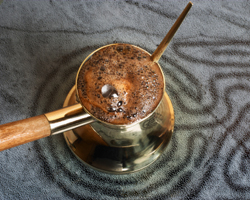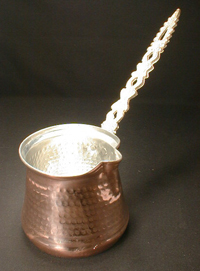

Turkish coffee is coffee prepared by boiling finely powdered roast coffee beans in a pot, possibly with sugar, and serving it into a cup, where the dregs settle. It is common throughout the Middle East, North Africa, Caucasus, and the Balkans, and in their expatriate communities and restaurants in the rest of the world.
The necessary equipment to prepare Turkish coffee consists of a narrow-topped small boiling pot called an ibrik, cezve, džezva, xhezve or μπρίκι (bríki) (basically an ewer), a teaspoon and a heating apparatus. The ingredients are finely ground coffee, sometimes cardamom, cold water and (if desired) sugar. It is served in cups (fincan, fildžan,filxhan or φλιτζάνι (flidzáni)) similar in size to Italian espresso or Japanese sake cups. Some modern cups do have handles. Traditional cups did not, and coffee was drunk either by handling the cup with the fingertips or, more often, by placing the cup in a zarf, a metal container with a handle.
Traditionally, the pot is made of copper and has a wooden handle. The size of the pot is chosen to be close to the total volume of the cups to be prepared, since using too large a pot causes most of the precious foam to stick to the inside of it. Also, a certain depth of water is necessary in order for the coffee particles to sink. The teaspoon is used both for stirring and measuring the amount of coffee and sugar. The teaspoons in some other countries are much larger than the teaspoons in countries where Turkish coffee is common: The dipping parts of the teaspoons in these countries are about 1 cm long and 0.5 cm wide.
For heating, an ordinary stove burner is sufficient, but an overly strong heat source is undesirable, as the brewing time needs to be at least five minutes.

As with other ways of preparing coffee, the best Turkish coffee is made from freshly roasted beans ground just before brewing. A dark roast is preferable but even a medium roast coffee will yield a strong aroma and flavour. The grinding is done either by pounding in a mortar (the original method) or using a mill (the more usual method today), and the end result is a fine coffee powder. Beans for Turkish coffee are ground even finer than the grind used in pump-driven espresso makers; therefore, Turkish coffee should be powdery. It is the finest grind of coffee used in any style of coffee making.
For best results, the water must be cold. Therefore, if sugar is desired, an easily dissolvable form should be chosen.
The amount of water necessary can be measured using the cups. The coffee and the sugar are usually added to water, rather than being put into the pot first. For each cup, between one and two heaped teaspoons of coffee are used. In Turkey, four degrees of sweetness are used. The Turkish terms and approximate amounts are as follows: sade (plain; no sugar), az şekerli (little sugar; half a levelled teaspoon of sugar), orta şekerli (medium sugar; one levelled teaspoon), and çok şekerli (a lot of sugar; one and a half or two levelled teaspoons). The coffee and the desired amount of sugar are stirred until all coffee sinks and the sugar is dissolved. Following this, the spoon is removed and the pot is put on the fire. No stirring is done beyond this point, as it would dissolve the foam. Just as the coffee begins boiling, the pot is removed from the fire and the coffee is poured into the cups.
Information Source: Wikipedia and Image Source: Fantes
Java
Drip Brew | French Press | Percolator | Vac Pot | Chemex
Pour-Over | Instant | Espresso | Grinding | Water Quality | Java Overview

















































